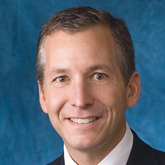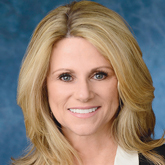How healthcare facilities across the nation are overcoming countless challenges—and what comes next
The COVID-19 pandemic is the one of the biggest health events to ever hit our country. The public is counting on hospitals now more than ever—and they’re stepping up. Not only have hospital favorability ratings increased since the pandemic began (from 73% in June 2013 to 86% in April 2020), but the general public’s trust in hospitals has also risen, according to recent survey data from Jarrard, a healthcare communications and consulting firm. Trust has increased in nurses by 73%, in doctors by 71% and hospitals by 68%.
From major academic medical centers to small community hospitals, healthcare facilities across the nation have risen to the occasion by fighting the pandemic all while keeping their providers and patients safe. So, what have we learned?
HealthTrust members and Physician Advisors weigh in on some of the challenges they’ve seen, how they’re combating them, and how this pandemic has changed the face of both traditional and emergency planning for years to come.
Bracing for the unknown

HealthTrust Physician Advisor Kelly Moore, M.D., MPH, President of The Vaccine Advisor and Associate Director of Immunization Education with the Immunization Action Coalition, says the biggest challenge most health systems faced early on in the pandemic was simply fear of the unknown—experts didn’t understand the case fatality rate or all the ways in which the virus could be transmitted, among many other mysteries.
Health systems not only worried about whether they’d have enough tests and personal protective equipment (PPE), but also how to treat patients who tested positive for the virus.
“It’s like we’re playing chess against a completely unknown opponent for the first time, and that opponent has surprising moves that create great challenges for us,” says Dr. Moore, who is based in Nashville, Tennessee. She previously oversaw the pandemic response plan and immunization program for the state of Tennessee.

HealthTrust Physician Advisor Bryan Fisher, M.D., Chief of Vascular Surgery at TriStar Centennial Medical Center in Nashville, Tennessee, adds that the lack of testing early on made it difficult to identify who had the virus, creating a host of problems. “We didn’t really have a great gauge of where to start,” he says. “The only way to mitigate what we were anticipating was obviously to take very austere measures and limit the number of patients in the hospital.”

And as health systems across the nation gained more knowledge about the virus and testing became more available, the challenge shifted from fear of the unknown to facing concrete problems head on. While large medical centers in urban areas like New York City, Chicago and Los Angeles had pressing challenges, smaller community hospitals had their own set of obstacles, says Christopher Rehm, M.D., Chief Medical Officer at LifePoint Health—a system based in Brentwood, Tennessee, that operates 88 community hospitals across the country.
“While we might not be in a large metropolitan area that has community spread, COVID-19 has still put our hospitals under stress,” Dr. Rehm says. For instance, one LifePoint facility—Sumner Regional Medical Center in Gallatin, Tennessee—saw more than 100 COVID-19-related visits in one weekend from a nearby nursing home well before community spread began in that area.
“We’re not in the middle of a city with a population of millions, but we do have clusters of vulnerable populations living in long-term care environments, which can be a source of a surge.”
Reacting to the realities
In light of the uncertainties and daily challenges, hospital systems have had to pivot their priorities and find new and innovative ways to serve their patients. Here are some of the biggest hurdles hospitals have faced during the COVID-19 pandemic:
Elective surgeries
Following federal- and state-mandated orders, most healthcare institutions began postponing elective surgeries in mid-March to preserve resources and ICU beds in the event of a surge in COVID-19 cases.
At TriStar, Dr. Fisher says elective vascular surgery cases, such as endarterectomies for asymptomatic carotid disease, nonurgent aneurysm repairs, angioplasty for lifestyle- limiting claudication and AV fistula placement for new dialysis access, were all postponed.
Most healthcare facilities have phased elective surgeries back in with an emphasis on close preoperative observation. For example, LifePoint hospitals have patients monitor their temperature in the week leading up to surgery, and then test patients for COVID-19 before surgery.

At LifePoint, surgeries are slowly being phased back in based on the COVID-19 situation at each hospital, says Chief Nursing Officer Michelle Watson, RN, MSN. “It’s very controlled,” she says. “It’s not something that just opens all at once.”
Supply chain & pharmacy management
Lack of PPE and essential drugs was a major concern for most medical institutions at the beginning of the pandemic.
Dr. Fisher says, luckily, TriStar has not seen a break in the supply chain, in part because it took conservative measures early on in order to preserve resources. “I don’t think we’re really at risk of running out of supplies,” he says. “Having a network of eight hospitals, you can aggregate resources almost in real-time and be nimble enough to make changes for each individual hospital.”
Dr. Rehm says LifePoint is in a similar situation, as it can freely move supplies among its 88 facilities. “We’ve had the ability to look at pharmaceuticals, PPE and even ventilators from the perspective of: If we need to, can we move them around based on where this is impacting us?” he says.
Early on, there was ample concern about shortages in intravenous pain-control medications and paralytics for patients with COVID-19 in the ICU. Dr. Rehm explains that to prepare for this potential shortage, LifePoint’s pharmacy director provided educational resources on equivalent drugs that were just as effective while supply chain staff worked on securing both the primary medications and their alternatives.
Staffing
COVID-19 has presented a learning curve for nurses, physicians and other medical personnel who have been deployed into new roles. Watson explains that operating room nurses who were no longer working on elective surgeries, for example, had to learn new workflows when deployed to different units. Some physicians who had worked in an outpatient setting for years now had to adapt to working with patients in a hospital environment.

HealthTrust Physician Advisor William Sistrunk, M.D., FACP, an infectious disease physician with Mercy Health in Springfield, Missouri, and Clinical Vice President of Mercy Lab, says his system faced staffing issues, but in a less traditional sense. The pandemic hit right around the time of spring break. The Centers for Disease Control and Prevention (CDC) had begun recommending that people who visited certain countries voluntarily quarantine upon returning to the U.S.
“We had a lot of staff who were out. We were short on emergency room physicians, ICU nurses and other providers in a lot of different pockets,” he says. To respond, they moved providers and coworkers from other areas to help care for patients and used telemedicine to supplement care.
Moving forward

HealthTrust Physician Advisor Pete Brookmeyer, M.D., an infectious disease specialist with Centura Health in Colorado Springs, Colorado, says he believes one big lesson health systems have learned from the COVID-19 pandemic is the necessity of a robust stockpile.
“I think there needs to be some kind of central stockpile at larger institutions, so we have enough supplies that get rotated out periodically and don’t expire,” he says.
Dr. Sistrunk agrees, adding that facilities will also need to think more about storage space moving forward. Most health systems don’t have warehouses, and storage space can be expensive. “That’s a continued cost, which is why health systems don’t just buy pandemic PPE supply,” he says. “It’s a challenge.”
Dr. Rehm and Watson say COVID-19 has highlighted the importance of providing front-line staff with everything they need to thrive.
“The length of this pandemic and keeping people resilient is a new aspect we’ve incorporated into emergency preparedness that I can’t imagine will go away in the future,” Dr. Rehm says.
Dr. Fisher believes the COVID-19 pandemic has demonstrated that having efficient communication within a health system is vital. (See our article on communicating during a crisis.) “We’ve seen that from an organizational standpoint,” he notes. “When you have a crisis come through, you have to be prepared at different levels. You have to communicate if you want to end up succeeding.”
Dr. Moore agrees, noting how essential it is to do thorough emergency and traditional response planning ahead of time—not in the midst of a crisis. “My hope is that this virus and the severity of it will hold us accountable in our planning processes in a way that we weren’t always accustomed to in the past,” she adds.
For more information on optimizing your supply chain, contact Drew Preslar, AVP Supply Chain Advisory Solutions.
Share Email COVID-19, Disaster & Emergency Preparedness, Operations, Q3 2020, Staffing




